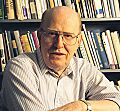A. R. Ammons facts for kids
Quick facts for kids
A. R. Ammons
|
|
|---|---|

Ammons in 1998
|
|
| Born | February 18, 1926 near Whiteville, North Carolina |
| Died | February 25, 2001 (aged 75) Ithaca, New York |
| Occupation |
|
| Nationality | American |
| Education | Wake Forest University University of California, Berkeley |
Archibald Randolph Ammons (February 18, 1926 – February 25, 2001) was an American poet and a professor at Cornell University. He wrote almost 30 books of poems during his life. Ammons is known for his influence on American romantic poetry. He won many important awards for his work. These include two National Book Awards for Poetry. He won in 1973 for Collected Poems and again in 1993 for Garbage.
Contents
What Was Ammons's Poetry About?
A. R. Ammons's poems often explored the connection between people and the natural world. He was similar to earlier American poets like Ralph Waldo Emerson and Walt Whitman. Ammons wrote about everyday life and nature.
What made Ammons special was his deep knowledge of science. He used many scientific words in his poems. He was also known for his clever and sometimes funny humor. This humor helped balance the serious topics he wrote about.
Ammons's Early Life and Education
Ammons grew up on a tobacco farm. It was located near Whiteville, North Carolina. During World War II, he served in the U.S. Navy. He worked as a sonar operator on a ship called the USS Gunason.
After the war, Ammons went to Wake Forest University. He studied biology there and graduated in 1949. Later that year, he became a principal and teacher at Hattaras Elementary School. He also married Phyllis Plumbo. Ammons then earned a master's degree in English from the University of California, Berkeley.
Ammons at Cornell University
In 1964, Ammons joined the faculty at Cornell University. He taught creative writing there. He later became a special professor of English and a poet in residence. He retired from Cornell in 1998.
Many of his students became famous poets. These include Alice Fulton and Ann Loomis Silsbee. Ammons became good friends with literary critic Harold Bloom. Bloom helped make Ammons's work well-known early in his career. They wrote letters to each other for many years.
Ammons also became close with poet Robert Morgan. Morgan joined the Cornell English Department in 1971. Both poets were from North Carolina. They often praised each other's work.
Ammons found ideas for his poems in the nature around Ithaca, New York. His poems "Cascadilla Falls" and "Triphammer Bridge" are about local landmarks.
Awards and Honors
Ammons received many awards during his 50-year career. He won the U.S. National Book Award twice. Once in 1973 for Collected Poems, 1951-1971. The second time was in 1993 for Garbage.
In 1998, he received the Wallace Stevens Award. This award came from the Academy of American Poets. He also won a MacArthur Fellowship in 1981. This was the first year the award was given out.
Other awards include the 1981 National Book Critics Circle Award for A Coast of Trees. He also won the 1993 Library of Congress Rebekah Johnson Bobbitt National Prize for Poetry for Garbage. In 1975, he received the Bollingen Prize for Sphere. He also won the Robert Frost Medal from the Poetry Society of America.
Ammons was given the Ruth Lilly Prize. He also received fellowships from the Guggenheim Foundation and the American Academy of Arts and Letters. In 1978, he became a Fellow of the American Academy of Arts and Sciences.
Ammons's Poetic Style
Ammons often wrote his poems in stanzas of two or three lines. These lines usually did not rhyme. They also often had enjambment, meaning sentences continued from one line to the next.
Some of Ammons's poems were very short, just one or two lines. This form is called a monostich. Other poems, like Sphere, Tape for the Turn of the Year, and Garbage, were hundreds of lines long.
Ammons used punctuation in a unique way. The colon (:) was his "signature" mark. He used it often to connect parts of sentences. He usually avoided ending poems with periods. Instead, some poems ended with ellipses (...) or no punctuation at all.
Images for kids


